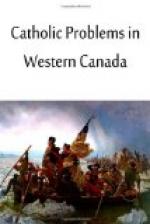The divine Founder of Christendom did not leave to several Churches the conservation and propagation of His doctrine. He founded only one Church and gave “unity” itself, as the supreme test of its divinity. Therefore the Church, that has remained “one” through time and space, and has conquered those two great enemies of unity, bears the birth-mark of its divine origin. The Catholic Church alone makes that specific claim. History is there to substantiate it. Matthew Arnold himself could not help acknowledging this universal fact. “Catholicism is that form of Christianity which is the oldest, the largest, and most popular. It has been the great popular religion of Christendom. Who has seen the poor in other churches as they are seen in Catholic Churches? Catholicism envelopes human life, and Catholics in general feel themselves to have drawn not only their religion from their Church, but they feel themselves to have drawn from her, too, their art, poetry and culture. And if there is a thing specially alien to religion, it is division. If there is a thing specially native to religion it is peace and union. Hence the original attraction towards unity in Rome, and hence the great charm when that unity is once attained.” The sharp contrast between the actual restlessness and uncertainty of the dissident Churches, and the calm assurance and self-possession of the Catholic Church, is not that an abiding proof of the security of the Catholic position?
Father Palmieri, O.S.A., Ph.D., D.D., who has made the problem of Christian Unity a life-study, made, in a recent article, these pertinent remarks: “The reunion of Christianity in the Catholic sense is not a Babel-like confusion of different sects which oppose creed to creed, which proclaim their absolute indifference in the doctrinal field, which take the individual reason as a judge of Christian revelation or Christian discipline. It would be an absurdity to suppose for a moment that Catholicism or Catholic Theology would propose this hybrid confusion of concepts and human caprices under the name of unity. For Catholicism and Catholic Theology, the reunion of Christianity is the return of dissident Churches and of the non-Catholic sects to Christian unity, to the one Church of Jesus Christ, which not only teaches this unity theoretically but also puts it into practice, in its doctrine, in its government, in its dogmatic and moral teaching, in its principles of authority. By logical sequence the Church of Jesus is one. This unity is not broken by political barriers, by ethnic divisions, by opposing national aspirations. To tend therefore toward Christian unity signifies to tend toward the only Church of Jesus Christ, and to effect this unity is the same as to adhere to it.”




